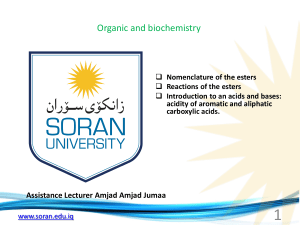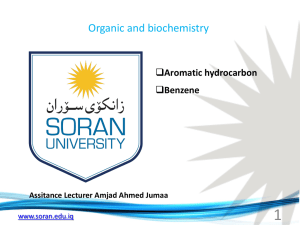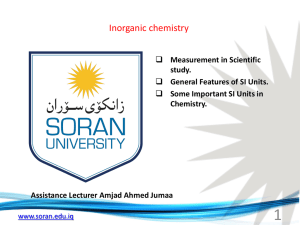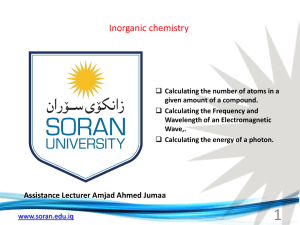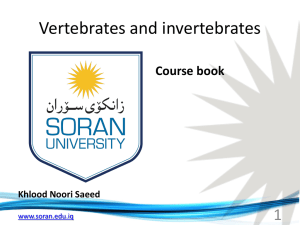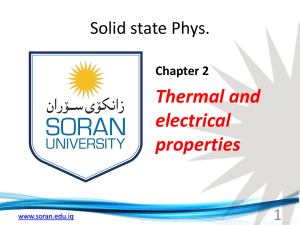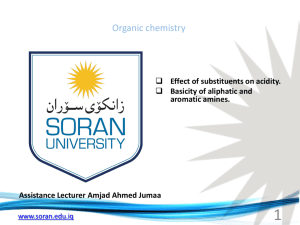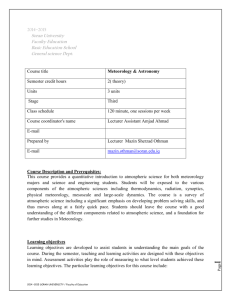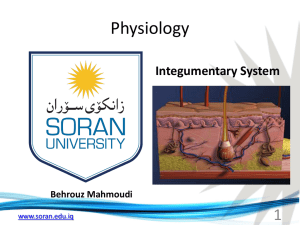Kazem.R.Abdollah Synthetic Organic Chemicals
advertisement
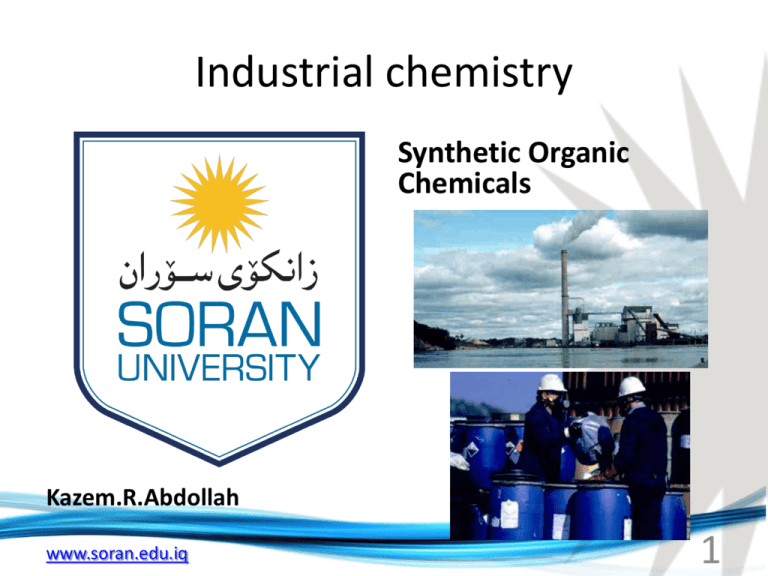
Industrial chemistry Synthetic Organic Chemicals Kazem.R.Abdollah www.soran.edu.iq 1 Introduction Synthetic organic chemicals are produced by the transformation of carbonaceous feedstocks into functionalized molecules through one or more chemical reactions. Such transformations are accomplished at vast industrial scales and the resulting products permeate every aspect of modern society. The molecules produced find use largely as monomers for polymer synthesis of ubiquitous plastics, or as task-specific ingredients for a myriad of applications as divergent as paint leveling agents to food preservatives. www.soran.edu.iq • Although many different chemicals can be made from each of the feedstocks, only a limited number of different types of chemistry have found particular favor in large-scale commercial production of synthetic organic chemicals. These include: • (1) oxidation • (2) carbonylation • (3) hydroformylation • (4) chlorination • (5) condensation • (6) hydration/hydrolysis • (7) esterification • (8) hydrogenation • (9) dehydrogenation • (10) sulfonation • (11) ammonation/ammoxidation. www.soran.edu.iq Chemical Raw Materials and Feedstocks • Five major types of feedstocks: 1. Light olefins—ethylene and propylene 2. Aromatics—benzene, toluene, xylenes, or BTX 3. C4 hydrocarbons—butanes, butenes, butadiene 4. Kerosene derived C9-C17 paraffins 5. Synthesis gas—a mixture of carbon monoxide and hydrogen www.soran.edu.iq Chemical raw material-feedstock-derivatives overview www.soran.edu.iq Light Olefins C2-C3 • Ethylene and propylene are by far the most important building blocks of the petrochemical industry. Ethane www.soran.edu.iq Propane Light olefins can be produced from a variety of raw materials and methods: 1. Steam cracking (thermal pyrolysis) of hydrocarbon raw materials ranging from LPG/NGL to naphthas and gas oils 2. Methanol to olefins 3. Recovery from refinery gases and FCC (fluid catalytic cracking) gases 4. Interconversion of butenes, ethylene, and propylene 5. Dehydrogenation of propane (propylene only) 6. Dehydration of bio-derived ethanol (ethylene only) www.soran.edu.iq 1.Steam cracking Steam cracking accounts for almost all of the ethylene and about 60% of the propylene produced worldwide. Hydrocarbon raw material 775–9500C ethylene/ propylene 0.17–0.24 Mpa In a short residence time tubular reactor/furnace Steam water The yield of ethylene vs. propylene is highly dependent on the: hydrocarbon raw material used as well as the severity of conditions. Ethylene production is favored by use of light hydrocarbons and higher temperature conditions. Major by-products are methane, hydrogen, butanes/butenes/butadiene, pyrolysis gasoline (benzene, toluene, C8 aromatics), and heavy oils. www.soran.edu.iq 2.Methanol to olefins Methanol could be reacted over acidic zeolites at high temperatures to produce primarily an aromatic-heavy gasoline as well as some C2-C4 olefins. www.soran.edu.iq 3.Recovery from refinery gases and FCC (fluid catalytic cracking) gases About a third of propylene is recovered from refinery operations, such as FCC of heavy oils. FCC produces primarily motor gasoline components, but also 5–9% propylene, which can be recovered by fractionation. www.soran.edu.iq C6-C8 Aromatics: BTX (benzene, toluene, o-,m-,pxylenes) The most important aromatics for chemical production are benzene and p-xylene. Globally BTX is produced primarily by catalytic reformer operations (55–60%), and by recovery from pyrolysis gasoline (40–45%). Benzene www.soran.edu.iq Toluene 1. Hydrodealkylation involves the thermal or catalytic reaction of alkylated aromatics (normally methyl aromatics) with hydrogen to produce light alkanes (normally methane) and benzene. • temperatures stay below 5000C to prevent metal sintering • pressures from 2.5 to 7.0 Mpa • Common catalysts are Group VIII metals and metal oxides, e.g., chromium oxides, Pt, Pt oxide, on alumina www.soran.edu.iq 2.Transalkylation/disporportionation involves the migration of methyl groups among aromatic rings in the presence of hydrogen. For example two toluene molecules produce a mixture of xylene isomers. • The reaction proceeds over aluminosilicate or silicoaluminophosphate zeolites (often containing noble metal (Pt) or rare earths) • at 400–4700C • pressures of 1.4–3 MPa www.soran.edu.iq 3.Toluene methanation is a process to convert toluene to xylenes that has been commercialized in the last decade to a limited extent. Methanol is reacted with excess toluene at high temperature over acidic or zeolite catalysts to produce xylene isomers and water. Toluene is distilled and recycled, while the product mixture of xylene isomers must be separated and isomerized to maximize p-xylene. Shape selective, para-enhancing zeolites are also used here. www.soran.edu.iq Synthesis Gas • Synthesis gas, or “syngas,” is a mixture of hydrogen and carbon monoxide produced by the partial oxidation of carbonaceous feedstocks. • Syngas production involves the breaking of C–C and C–H bonds of the raw material molecules at high temperature via reaction with water (steam reforming), oxygen (partial oxidation), or carbon dioxide (carbon dioxide reforming), or combinations therein (autothermal reforming or gasification). www.soran.edu.iq • The primary reactions in steam methane reforming (SMR), stream hydrocarbon reforming (SHR), and carbon dioxide reforming (CMR—not yet commercial) are endothermic, with only the water-gas shift reaction providing heat. www.soran.edu.iq • Syngas can also be produced by partial oxidation, typically with high purity oxygen (to avoid dilution with large quantities of hard to separate nitrogen). www.soran.edu.iq • Gasification of solid carbonaceous raw materials adds additional endothermic reactions of solid carbon with steam and exothermic reactions with oxygen. • Methanation may also occur under appropriate conditions. www.soran.edu.iq www.soran.edu.iq

